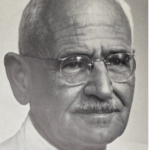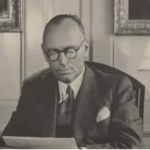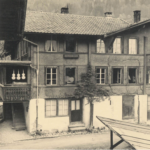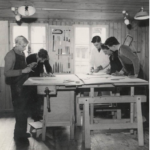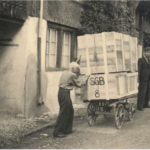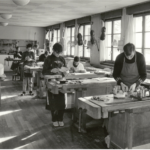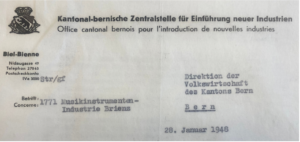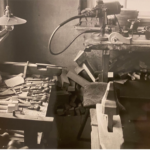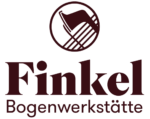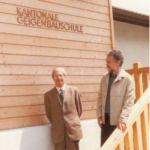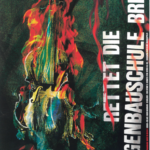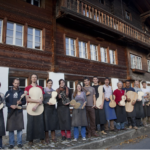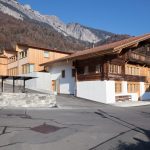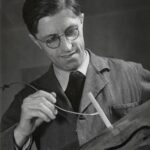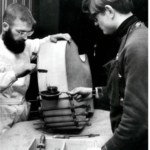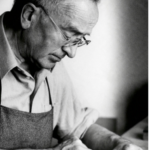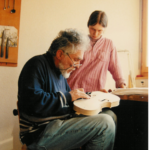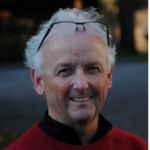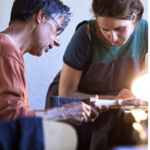Why in Brienz?
Brienz has a long and venerable woodcarving tradition. Initially, wood- carving mainly served to manufacture utensils. Once the tourism industry started to boom in the first half of the 19th century, the production of souvenirs and objects of art developed into a vital business sector. Around 1880, approx. 2‘000 woodcarvers are believed to have worked in the Berner Oberland region. The Schnitzlerschule, today‘s School for Wood Carving, was established in Brienz in 1884.
During the times of crisis in the first half of the 20th century, the tourism industry in the Alpine region collapsed. Many woodcarvers were unemp- loyed. Given this background, the initiators of the School of Violin Making believed that adding a complementary artisanal industry to the existing woodcarving industry in Brienz would offer new potential for the region. Their idea was to give unemployed woodcarvers the opportunity to earn additional income by training them to produce accessories for the manu- facture of string and plucked instruments, as well as training up violin makers in Brienz. However, this plan never materialised in the envisaged form.
Establishment
The Swiss School of Violin Making owes its existence to the initiative of two gentlemen from very different backgrounds.
Prof. Dr. Heinrich Hanselmann, Professor for Remedial Education at the University of Zurich, music lover and owner of a collection of over 200 Swiss violins, was passionate about «the encouragement of violin playing and the cultivation of music at home». By contrast, the Bern-based Government Councillor and Director of Economic Affairs Dr. Max Gafner focused on «creating and safeguarding the Swiss sales industry». Together they set up the «Association of friends of the Swiss violin» in 1943. Among the association’s aims was the establishment of a school of violin making.
1944 – Opening
Teaching started on 1 July 1944. The early phase of the School of Violin Making was dominated by precarious circumstances, involving very basic working conditions and a bleak financial situation.
1952 – Relocation to «Schnätzi» school
Prospects improved in the 1950s when the School was brought under government control. It becomes a department of the «Schnitzlerschule» (today’s school of wood sculpture).
Introduction of new industries
Against the background of the economic crisis in the pre-war and inter-war years, Switzerland was working to step up regional development strategies. Economic stimuli were needed in particular in the more disadvantaged regions. Following the example of the Canton of St. Gallen, the Executive Council of Bern decided to establish a «Central authority for the introduction of new industries» in 1932. The mid-1930s already saw a number of success stories, among them the siting of a General Motors factory in Biel in 1935.
On the initiative of Councillor Dr. Max Gafner, the economic development scheme in Bern adopted an ambitious plan in 1946 that involved the establishment of an instrument making industry in Brienz. The idea was to attract the renowned family enterprise Höfner from the west Bohemian town of Schönbach (today Luby/ Czech Republiv), which specialised in producing string and plucked instruments based on a collaborative approach, to Switzerland. After the war, Höfner had been nationalised and placed under the administration of the Czech socialist government. The former owner and his staff were eager to leave the country. Engineer Strauss, the head of the Biel authority for the introduction of new industries, travelled incognito to Schönbach and contacted Josef Höfner.
The plan was to establish Höfner and his staff in Brienz and the surrounding region. Up to 680 skilled workers and their families were to be settled in the area.
However, neither the «Friends of the Swiss violin» nor the immigration authority in Brienz had imagined a project on this scale. There was massive resistance, especially among Swiss violin makers, against bringing such formidable competition into the country.
For the time being, the project was delayed. In 1948, while the instrument makers from Schönbach languished in reception camps in Bavaria, negotiations restarted. Reduced to 24 families, then to 3, the project was dropped altogether in the end.
Meanwhile Brienz had put the project on ice, with one exception: the «Finkel Bogenwerkstätte» (Finkel Bows), a company from Markneukirchen in East Germany, moved to Brienz in the early 1950s. Located at Bogenweg 4 in Schwanden near Brienz, the company has been producing premium bows for the international market ever since.
1982 – Current location
In 1982, the School of Violin Making moved to its present site. The building was renovated and received an extension which from then on housed the training workshop.
Savings and private initiatives
The Canton of Bern was not immune to the Swiss real estate crisis and the recession of the 1990s. Like other authorities, the Bern education department was asked to come up with suggestions for savings. An extensive study was commissioned. According to the result of the «investigation» of several schools «with supra-regional importance», the continuance of the School for Violin Making was «no longer considered expedient» on economic grounds.
Despite widespread protest, a closing order was issued in May 1996, decreeing that the School be closed in 2000.
However, the Canton of Bern was willing to «make the existing infrastructure available if a private trust was prepared to raise its own funds to run the Brienz School of Violin Making».
The newly formed «Save the School of Violin Making» committee managed to create the formal and financial conditions necessary for the establishment of the «Brienz Violin Making School Foundation». Teaching operations continued without interruption.
Oberdorfstrasse 94 Today
Today, the whole property at Oberdorfstrasse 94 is owned by the Violin Making School Foundation. The land on which the freshly renovated and developed building is located belongs to the Canton of Bern. Since the building‘s conversion in the period 2016-18 and the rescission of the chalet‘s partition, school operations are housed across the entire building.
Pioneers
The teachers of the School of Violin Making have shaped generations of young apprentices and defined the history of the School. In addition to their responsibilities as teachers, they also had to act as entrepreneurs to secure the continuance of the School of Violin Making and develop the teaching operations.
Adolf König (1908-2000)
1944-1973
Zurich native Adolf König was the first principal of the School of Violin Making. In charge of the school for 30 years, he played a pioneering role.
Frans van Dijk (1936-2022)
1968-1970
By now, the School had 8 trainees.
For the first time, Adolf König had the means to employ a second teacher and shared the teaching responsibilities with Frans van Dijk for a two-year period.
Hugo Auchli (1923-2014)
1971-1986
The successor of Frans van Dijk, Hugo Auchli became an important figure in the lives of many violin makers.
Ulrich Walter Zimmermann (1934-2007)
1973-1996
Adolf König handed over the baton to his former student Ueli Zimmermann, another prominent figure who went on to campaign for the survival of the School in the 1990s.
Hans Rudolf Hösli (*1953)
1996-2019
Hans Rudolf Hösli became a specialist teacher and principal in 1996. Together with Simon Glaus, he steered the School through turbulent times. He was instrumental in the School’s privatisation and initiated its expansion in the years 2017/18.
Simon Glaus (*1958)
1986-2024
Simon Glaus took over from Hugo Auchli in 1986. On his retirement in 2024, he will look back on four decades of sharing his knowledge with future violin makers.


